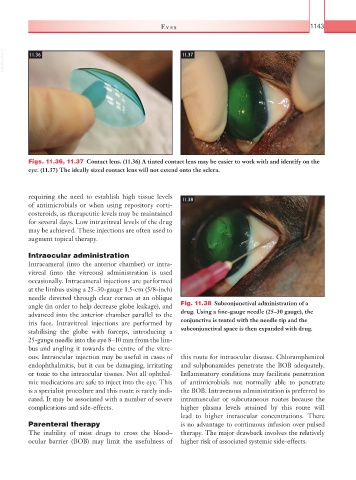Page 1168 - Equine Clinical Medicine, Surgery and Reproduction, 2nd Edition
P. 1168
Eyes 1143
VetBooks.ir 11.36 11.37
Figs. 11.36, 11.37 Contact lens. (11.36) A tinted contact lens may be easier to work with and identify on the
eye. (11.37) The ideally sized contact lens will not extend onto the sclera.
requiring the need to establish high tissue levels 11.38
of antimicrobials or when using repository corti-
costeroids, as therapeutic levels may be maintained
for several days. Low intravitreal levels of the drug
may be achieved. These injections are often used to
augment topical therapy.
Intraocular administration
Intracameral (into the anterior chamber) or intra-
vitreal (into the vitreous) administration is used
occasionally. Intracameral injections are performed
at the limbus using a 25–30-gauge 1.5-cm (5/8-inch)
needle directed through clear cornea at an oblique
angle (in order to help decrease globe leakage), and Fig. 11.38 Subconjunctival administration of a
advanced into the anterior chamber parallel to the drug. Using a fine-gauge needle (25–30 gauge), the
iris face. Intravitreal injections are performed by conjunctiva is tented with the needle tip and the
stabilising the globe with forceps, introducing a subconjunctival space is then expanded with drug.
25-gauge needle into the eye 8–10 mm from the lim-
bus and angling it towards the centre of the vitre-
ous. Intraocular injection may be useful in cases of this route for intraocular disease. Chloramphenicol
endophthalmitis, but it can be damaging, irritating and sulphonamides penetrate the BOB adequately.
or toxic to the intraocular tissues. Not all ophthal- Inflammatory conditions may facilitate penetration
mic medications are safe to inject into the eye. This of antimicrobials not normally able to penetrate
is a specialist procedure and this route is rarely indi- the BOB. Intravenous administration is preferred to
cated. It may be associated with a number of severe intramuscular or subcutaneous routes because the
complications and side-effects. higher plasma levels attained by this route will
lead to higher intraocular concentrations. There
Parenteral therapy is no advantage to continuous infusion over pulsed
The inability of most drugs to cross the blood– therapy. The major drawback involves the relatively
ocular barrier (BOB) may limit the usefulness of higher risk of associated systemic side-effects.

